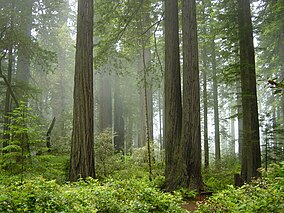Redwood National and State Parks
| Redwood National and State Parks | |
|---|---|
IUCN category V (protected landscape/seascape) | |
 Fog in the forest | |
| Location | Humboldt County & Del Norte County, California, US |
| Nearest city | Crescent City |
| Coordinates | 41°18′N 124°00′W / 41.3°N 124°W |
| Area | 138,999 acres (562.51 km2)[1] |
| Established | October 2, 1968 |
| Visitors | 482,536 (in 2018)[2] |
| Governing body | Co-managed by National Park Service and California Department of Parks and Recreation |
| Website | Official website |
| Criteria | Natural: (vii), (ix) |
| Reference | 134 |
| Inscription | 1980 (4th Session) |
The Redwood National and State Parks (RNSP) are a group of state and national parks in the United States. They are on the coast of northern California. These parks include Redwood National Park, Del Norte Coast Redwoods State Park, Jedediah Smith Redwoods State Park, and Prairie Creek Redwoods State Park. Together, the parks contain 139,000 acres (560 km2),[3]
The parks have old-growth temperate rainforests. The four parks include 45% of all remaining coast redwood forests. These total at least 38,982 acres (157.75 km2). These trees are the tallest and one of the biggest trees on Earth. In addition to the redwood forests, the parks protect much nature within the area.
In 1850, old-growth redwood forest covered more than 2,000,000 acres (8,100 km2) of the California coast. The northern part of that area was noticed by lumbermen and others when a gold rush brought them to the region. As they did not become rich from gold, these men decided to log the gigantic trees.[4] The timber went to San Francisco and other places on the West Coast.
After many decades of logging, efforts were started in conservation. In the 1920s the Save the Redwoods League worked to save old-growth redwoods. Due to their efforts, a number of State Parks were formed. Then in 1968, Redwood National Park was created. By that time nearly 90% of the original redwood trees had been logged. The National Park Service (NPS) and the California Department of Parks and Recreation (CDPR) combined the management of Redwood National Park with the three Redwood State Parks in 1994.[5]
The ecosystem of the RNSP preserves a number of threatened animal species. These include the tidewater goby, Chinook salmon, northern spotted owl, and Steller's sea lion.[6] The United Nations made the parks a World Heritage Site on 5 September 1980. Other parts of the area were added on 30 June 1983.[7][8]
References[change | change source]
- ↑ National Park Service, Land Resources Division (December 31, 2018), Listing of Acreage (PDF), archived (PDF) from the original on May 15, 2019, retrieved May 15, 2019.
- ↑ "NPS Annual Recreation Visits Report". National Park Service. Retrieved 2019-03-11.
- ↑ "National or State Park?" (PDF). Redwood National and State Parks Visitor Guide. National Park Service. June 24, 2010. Retrieved 2010-06-24.[permanent dead link]
- ↑ Coy, Owen Cochran (1982). The Humboldt Bay Region 1850–1875. Humboldt County Historical Society. p. 51.
- ↑ "Working Together". Redwood National and State Parks. National Park Service. Retrieved 2 April 2012.
- ↑ "Threatened/Endangered Species". National Park Service. Retrieved 2008-11-07.
- ↑ "U.S. World Heritage Sites". National Park Service. Archived from the original on 2008-10-13. Retrieved 2008-11-07.
- ↑ "U.S. Biosphere Reserves" (PDF). National Park Service. Archived from the original (PDF) on 14 March 2016. Retrieved 22 May 2016.
Related pages[change | change source]
Other websites[change | change source]
| Media from Commons | |
| Travel guide from Wikivoyage | |
- Official website of the National Park Service
- Chronology: Establishment of the Redwood National Park by Willard E. Pratt. Forest History Society website.
- The HSU Redwoods Project
- Inventory of the Redwood National Park Collection, 1926–1980 at the Forest History Society archives.


